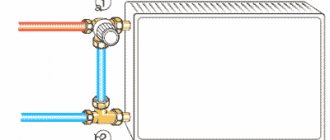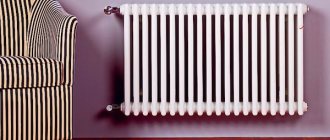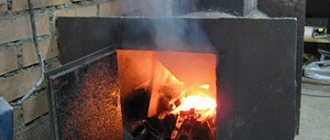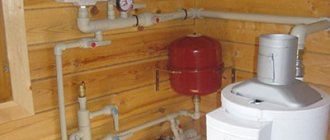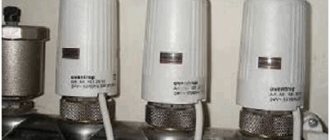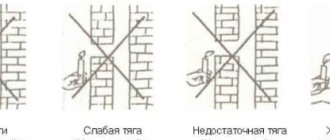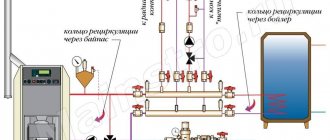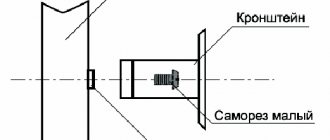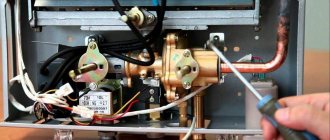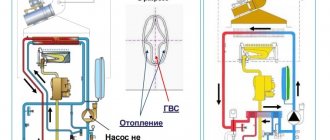There are frequent situations when the problem of a heating battery not heating arises. Sometimes you have to rack your brain in search of the reasons why the situation is happening and how to fix it. We have collected for you 7 possible reasons why radiators may not heat up and offer to study each in detail.
Important! This article is especially relevant when starting heating systems. Many, like you at the moment, may be experiencing difficulties with batteries. Your repost of our material may help someone quickly solve their problem. Don't forget to click on the social buttons. networks at the very bottom of the article!
Bypass
The bypass is the same pipe that stands in front of the installed heating device. Everyone has one, it’s needed to bypass water past the battery. If installed incorrectly - too far from the radiator, or in line with the central riser, it does not allow water, which tends to travel along the shortest path, to circulate normally, heating the radiator sections. In this situation, they will either not heat at all or will be very bad. Check how your bypass is installed. Perhaps this is the direct reason why the batteries do not heat up
Pipelines: reasons for low heating
Determining air pockets in batteries using a thermal imager
Failures in the heating mode are typical for a two-pipe heating system. In this case, the supply line that distributes the coolant to the radiators does not heat. Identification of the “problem” area can be done by measuring the temperature on the surface of the pipes or a thermal imager.
Natural circulation
Pipe slope for heating with natural circulation
What can cause such problems? If the heating does not heat well, the slope of the line may not be observed. This only applies to natural circulation systems. According to the standards, the slope of the pipes should be 10 mm per 1 m.p. In addition, the direction is taken into account - from the accelerating riser to the radiators. For the return pipe, the slope must be towards the boiler.
At the first stage, it is necessary to measure this indicator using a building level. If it meets the standard, but the heating radiator does not heat, there is a possibility of air pockets forming. In this case, an integrated approach is recommended, which includes the following steps:
- Measuring the angle of inclination. If necessary, change it to the required value;
- Flushing pipes to remove limescale;
- Filling the system with coolant with open Mayevsky taps on the radiators.
This technique will eliminate the low heat transfer rate of the heating system.
To improve circulation, a circulation pump can be installed in open systems. If it overheats, you need to install an additional one. This is often necessary for branched heating systems.
Three way valve
Such a tap is required to switch the bypass-battery direction. If this is the reason that the radiator does not heat, then the problem can be eliminated in 3 ways:
- No disassembly. In cases where the tap turns easily, but switching does not occur at all (neither one nor the other works), you can try to develop the device using multiple turning movements. In this case, blockages, as a rule, are washed away by the flow, going into the riser. The operation of shut-off valves is restored in full.
- With partial disassembly. There's no way to turn the tap? We're not trying to break it. Carefully unscrew the locking screw of the handle, remove it, place the screw back in order to prevent deformation of the part during further work. Further actions are carried out with a wrench. It is not recommended to use round nose pliers, pliers, etc. The reason is the same as with the screw - not to damage the rod. Holding the rod with a wrench, we smoothly rock it back and forth, starting with minimal vibrations. If you cannot make minimal movements, slightly loosen the large hex nut that presses the stuffing box seal. If it starts to dig in, place a small container. Continuing the work, moving the rod, press the seal into place, turning the large nut back accordingly. We unscrew the screw, install the handle, screw in the screw, and rejoice.
- In rare cases, when the internal stop is simply torn off, the crane has the ability to “spun in a circle” endlessly - we simply select the position of the handle in which normal operation is ensured.
Let's understand the reasons
The most common heating problems are divided into 2 types:
- The radiators heat up unevenly - they are warm at the top, cold at the bottom, the sections closest to the entrance are hot, the furthest ones are cold.
- The “trend” of the heating season is a hot riser, a cold radiator.
All owners of houses and cottages react the same way to a decrease in air temperature in the house by more than 10 degrees - they begin to panic! The owners urgently take out their savings to replace all the radiators in the house, and some even take out a bank loan for this purpose. “Well, what else can you do, don’t freeze?”
In fact, in most of these situations you shouldn't even think about replacing radiators. If the battery does not heat up, this does not mean at all that it needs to be replaced and spend money on it. Of course, expenses in such a situation cannot be avoided, but their scale can be significantly reduced.
So, the most “popular” reasons for cold batteries:
- the battery is mounted too close to the floor or wall;
- taps with insufficient flow area were installed;
- the battery is incorrectly selected;
- The radiator is not connected correctly;
- the pipe is melted at the joints and there is no free access to it;
- lack of balancing of the system after installation;
- pipes made of polypropylene (such material can allow air into the system);
- incorrect wiring.
Although the last option is quite rare in practice, it is the most costly in financial terms. When the radiators still heat up, albeit not at full power, repairs can be postponed, but if the air in the house barely warms up to +10 degrees, repairs cannot be delayed.
Regarding eliminating the problem itself: a lot here depends on the condition of a particular radiator, and on the general configuration of the heating system in the house, and on the service life of the radiators, etc.
But we want to remind you: if there is a problem with the heating, you need to use the help of a qualified specialist, and not try to deal with the problem yourself, risking your own repairs.
Human factor
A person can also become the direct cause of a non-heating radiator. And usually they are as follows:
- A riser that they simply forgot to turn on because “it was late and the plumbers were tired.”
- Closed valve of the automatic air vent system.
- Incorrect connection during installation.
- Child-closed three-way valve.
They can be solved by calling the appropriate support service, correctly connecting the battery (or bypass, see below), and carefully checking the taps.
Flow extender
A typical problem for a two-pipe system. Is it possible to make any number of sections? It is possible, but the very last sections of the battery will not warm up. Cause? Water, like a person, looks for “where it’s easier” and follows the shortest path. In order to “teach order” to the lazy one - water, a flow extender is required. Factory-made, or made independently from a piece of pipe. By directing the fluid to the middle of the structure, it will force the flow to circulate correctly, reaching the farthest ends of the heat exchanger.
Interesting fact: the same problem can be solved by connecting the heating device “diagonally”. But this is rarely used, due to the lack of aesthetics of this solution on ready-made systems.
Causes of cold radiators
If, with the onset of cold weather and the heating season, heating is provided to your home, but the radiators do not work, then the problem may be a technical malfunction or the functioning of the entire supply system.
Especially if we are talking about a city apartment, the provision of heat in which should be handled by the housing and communal services service or another authorized body that checks the preparedness of the entire system for the heating season. Well, in the case of a private house, solving problems falls on your shoulders. If you wish, you can contact the Eurolux Group company; this company will carry out all the work quickly and inexpensively.
And here it is important to understand the main causes and individual problems that will need to be eliminated in order for the batteries to give off the maximum amount of heat.
The main factors that cause batteries to remain cold can be identified:
- presence of air pockets in the heating system;
- technical blockage of a single battery;
- incorrect connection of each of the elements and the entire system as a whole.
These criteria can affect the performance of both the individual battery and the overall system. Only after these problems have been eliminated will it be possible to talk about the full functional operation of the heating system in each room.
Let's consider each reason separately.
This is interesting! Heat-reflecting screen behind the radiator: how to install it yourself and the advantages of using it
Air jams
When studying the functional features and eliminating the problems of cold radiators and batteries, it is important to take care not only of one of them, but also to check the condition of the entire system. This type of solution requires testing for operability in the presence of air pockets in the system.
Traffic jams can occur due to the appearance of excess air during radiator operation. At the same time, if we are talking about a city house, then, as a rule, the upper floors of high-rise buildings suffer.
But this problem can be easily fixed. To do this, in modern batteries special valves are installed in the upper part, which allow the accumulated air to be removed, restoring the operation of the system.
Heating system clogged
If heating has already been turned on in the system, and you still have cold radiators, there is a possibility that the existing system elements are clogged. This can be either the deposition of the corrosive properties of the metal or the gradual accumulation of scale and large amounts of dirt on the walls of radiators.
To perform flushing efficiently and quickly, follow these recommendations:
- move furniture aside, remove curtains, cover the floor with cellophane or cloth to avoid damage;
- shut off the coolant supply using the shut-off valve. If it is not installed, remove the battery, unscrew it and pour the liquid into a basin;
- to clean the radiator, it must be moved to a bathtub, at the bottom of which it is recommended to place a wooden floor;
- Using a wrench, unscrew the end caps and allow the dirty liquid to flow out of the battery into the bath;
- pour water under pressure from a hose into the battery;
- If a crystalline blockage has formed, it should be cleaned using a special reagent. Through the use of a chemical formula and high-quality pressure in the system, it is possible to remove existing problem areas of scale and corrosion and obtain warm and fully functioning batteries again. You can also use a 70% solution of vinegar and water;
- pour the reagent or vinegar solution into the battery, close the seals and let it brew for 2 hours;
- Rinse the battery inside and outside under high pressure water, wipe the battery dry and install it on the bracket.
Balancing valve
Privately owned houses have the greatest variety of heating systems. Cases of two or three branch structures are not uncommon. In this case, as in the above cases, the tendency of the liquid to take the shortest route naturally remains. The longest arm may have no circulation at all or very weakly expressed. The heat transfer of such a link will be the same - small, absent. The battery will not heat or heat poorly.
To eliminate the situation, it will be necessary to install a balancing valve in order to equalize the pressure of different branches and uniform heating.
Adviсe
So, if you find that the radiators in the apartment have become cold or not warm enough, we recommend doing the following:
- Determine the type of possible breakdown. If this is a separate battery, then it is necessary to shut off the flow of coolant into this element. This can be done using a supply valve.
- Wait for the liquid to cool and disconnect the damaged, non-functional battery.
- Clean the system or install a new battery.
- Allow coolant to flow in and check the operation of the entire system.
Today, important parameters when choosing radiators and radiators are heat transfer and efficiency. Thoughtful solutions using the quality characteristics of metal make it possible to obtain not only durable, but also more practical elements for heating an apartment or room.
That's why many people strive to replace old cast iron batteries and install modern and more economical ones. In addition, the aesthetic appearance of the batteries is not the least important. Today there is a choice of batteries that are ideal for the interior, creating comfort and coziness in the room.
In any case, when selecting and repairing a heating system, it is important to correctly identify the cause and eliminate it before the onset of cold weather. In this way, it is possible to avoid freezing of the entire system, the repair of which will cost much more than an individual element.
This is interesting! Electric heating radiators - which are better: classification and advantages of different types
What to do if the radiators in the apartment are cold, see the following video:
Very often on thematic forums the question of why the last battery is cold is discussed. This applies to both the heating circuit of a private house and the distribution of centralized heat supply in multi-apartment buildings. A situation may also arise when the heating element does not heat while being in the middle of the wiring. It is impossible to answer such questions unambiguously. After all, there can be many reasons for such a situation. Also read: “Why is half of the radiator cold?”
Clogged radiator
Sometimes the reason that the radiator does not heat can be a simple blockage. When determining the causes of blockage, let’s highlight the symptoms:
- It only warms around the perimeter.
- Only the top part.
- The bottom is heated, the top is not.
- Only a few sections out of all possible provide heat (if the bypass location is correct)
Could it be just the old battery that is clogged? Not at all. New systems (modern and ultra-modern, aluminum and cast iron) suffer from this just as often. The problem may lie in the general contamination of the system:
- From long-term use.
- Due to installation errors.
- Sediments with high water hardness.
- Erosion of system elements (oxide, rust).
Incorrect battery connection
Incorrect or ineffective connection of the radiator is also the reason for its poor heating. The best option is to supply water to the top hole of the battery and exit through the bottom. In this case, both connections must be on the same side.
Options for connecting the battery to the system
The cross method involves the return outlet on the other side of the radiator. This is also an efficient option that allows only 2% heat loss. There are other connection options, but they have more noticeable losses.
Incorrect radiator connection
An incorrect connection can completely deprive you of heat . This includes the case when the supply is installed in the lower hole, and the outlet in the upper. If such installation errors occur, they should be eliminated as soon as possible.
Airy radiator
The presence of a large air bubble in the system is an obstacle to the normal circulation of coolant through the system of pipes and heating devices. The symptom is cooling of the entire radiator or the far upper part of it when the riser is hot.
Complicating the situation is the possibility of the simultaneous existence of obstacles of this kind. In centralized heating systems, automatic air exhaust systems are installed to prevent such situations.
Interesting fact: this type of malfunction is most often found in single-pipe systems of the Leningradka type, due to the peculiarities of connecting the radiator - the pipe is only at the bottom.
In private homes and autonomous heating systems, the “Mayevsky tap” serves the same purpose. “De-airing” of an autonomous system, if available, can, as a rule, be carried out on its own. Taking a small container or a cloth, turn the tap, release the air until the first drops appear, and close it by turning it to the previous position.
Without this useful part of the system, everything looks a little more complicated. In a private house, you can look for an air vent valve in the attic. Is this tap missing? After allowing the system to cool to temperatures of 15-21 degrees Celsius, the heating should be restarted at full power. Increased pressure has every chance of squeezing the air lock into the expansion tank, and everything will work and warm up again.
In apartment buildings in such a situation, it is inevitable to call a specialist - a plumber from a service company (emergency service) who will carry out the required work. Especially if you live on the lower floors of the house, since the problem is localized at the upper levels.
Interesting fact: “Maevsky tap” is available for all types of radiators and can be installed on a ready-made system (when there is no coolant in it).
These are the most common reasons why the radiator does not heat. Check each one for yourself. If it works, then great. If not, then you should call a specialist who will probably notice what you failed to notice.
Very often on thematic forums the question of why the last battery is cold is discussed. This applies to both the heating circuit of a private house and the distribution of centralized heat supply in multi-apartment buildings. A situation may also arise when the heating element does not heat while being in the middle of the wiring. It is impossible to answer such questions unambiguously. After all, there can be many reasons for such a situation. Also read: “Why is half of the radiator cold?”
Some tips for craftsmen
Many problems can be avoided if you do a few things first. Autonomous heating of a private house has an expansion tank for the system. If you weld a faucet to the lower pipe and gradually feed water into it, the air lock will escape through the tank. The system is filled with water through the same tap, then plugs will not appear. The only thing required is an assistant to monitor the water level in the tank.
To remove air from cast iron batteries, install a Mayevsky tap on the top plug. This is not at all difficult, you just need to unscrew the plug in the summer, drill a hole of the required diameter in the center and cut the thread with the required pitch. The plugs are made of cast iron, the material is easy to process.
If the battery does not give off heat well for no apparent reason, it may be touching the wall. The larger the contact area, the more heat is wasted. Eliminate contact by moving the radiator slightly away. Do not cover the batteries with decorative grilles, which reduce heat transfer. It is better to attach a reflective screen made of foil material behind the radiator - heat transfer will increase.
The heating system seems simple only at first glance, but in fact it has its own secrets and tricks. Everything seems complicated and confusing for a beginner. But once you understand the issue, the main points become clearer.
Global heating circuit problems
Kote doesn't like cold batteries.
The reasons why one battery is hot and another is cold can be global in nature:
- the bypass is installed incorrectly;
- no balancing;
- insufficient pressure.
The bypass is not installed correctly. The bypass is a tube in front of the radiator. It connects the supply of heated coolant and the return. The last battery does not heat well if the bypass is installed too far from it. After all, according to the laws of physics, it will be easier for the coolant to pass through the bypass than through the entire heating element.
The bypass taps directly into the wiring, rather than through a two- or three-way valve. The coolant enters the radiator through outlets. As a result, the cross-section of the supply pipes decreases. There is not enough pressure in the system to push hot water through the circuit. As a result, the last heating radiator does not heat.
Often, when the heating circuit is first started, the last battery in the house does not heat. What to do? Experts recommend not taking radical actions and allowing the system to level out. The air that is in the water must come out naturally. After some time, the heating wiring will function normally.
Error in bypass circuit.
Incorrect installation of the radiator. Why doesn't the last battery heat up? The last radiator in the heating circuit may be too large. It contains more than 12 sections. In this case, the pressure in the system is not enough to drive the coolant through the entire volume of the heating element. The situation is aggravated by the lateral connection. Hot water does not reach the outer sections. As a result, the last heating radiator does not heat well.
Incorrect balancing. Balancing the system means uniform distribution of the coolant throughout the entire heating circuit. It is performed using shut-off and control valves and thermostats. If the last battery in the heating system is cold, then perhaps the problem lies in the uneven distribution of hot water throughout the wiring.
Everything about plastic pipes for heating: characteristics, dimensions, installation.
What thickness should steel pipes be for heating? The answer is here.
No circulation, heating failure - why
Failure in the heating system, deficiencies, imperfections, all lead to cold radiators. If there is no coolant circulation, then the reason needs to be determined. Most often, the answer to why the heating does not work is on the surface, obvious.
Let's look in order at the main causes of heating malfunctions, why water does not circulate through the pipes, and what needs to be done first.
Let's start with the simplest and most obvious reasons.
clogged, clogged
Every heating system must have a coarse filter. A very small device with a fine mesh and a sump (installed downwards! or at least to the side) saves equipment, pumps, and the boiler from coolant contamination that will be present in any system. Wood shavings, broken threads, rust, water sediment…. everything is retained by the mesh in the filter.
The sedimentation tank must be periodically untwisted and the mesh cleaned.
If the circulation in the heating system of a private house is disrupted, then the first thing you need to do is check the filter, which should be installed on the return line in front of the boiler.
Air in the system, airing
Airing can occur in any closed piping system where air removal measures have not been taken. Air is always present in the coolant, including in a dissolved state, is released during pressure changes, and accumulates at the highest points. Including in the boiler.
Automatic air vents are installed at characteristic, highest points of the system, as well as on collectors and special separators - the normal circuit is equipped with a special air catching device in which air bubbles are released from the coolant.
We recommend: DIY heating radiator
In addition, Mayevsky valves (manual air vents) should be on each radiator, and also possibly in other elevated places.
Checking the air supply, bleeding the air, installing air vents are common actions if circulation stops and the batteries are cold.
The circulation pump does not work
In private homes, the reason why the heating system stops working is a breakdown of the electrical equipment that controlled the movement of the coolant through the pipes.
If the heating suddenly stops working, then you need to check the functionality of the circulation pump near the solid fuel boiler or the pump in the automated boiler. In addition, the same unit can be installed in each circuit, which must work properly.
Bad polypropylene pipes
Often the consumer (customer) believes that polypropylene pipes are absolutely reliable and cannot cause heating problems or cold radiators.
But polypropylene is much more insidious than old steel or metal-plastic pipelines. Each place of soldering (welding) is a potential increased resistance in the system or a cause of cessation of circulation (weakened movement of water through the batteries), due to deposits of material inside.
It is impossible to control the quality of connections from the outside; all that remains is to cut out pieces, resolder, and remake polypropylene pipes.
Poor performance of a polypropylene system is a real problem for the home installer. Good professionals don’t take on this material at all.
Bad project
It is not uncommon for poor circulation to occur where there is poor design. Typically, the batteries are not connected correctly, according to some sequential circuit, where the last battery in the circuit receives much less coolant.
Another bad design is single-pipe circuits, where it is also difficult to establish the necessary coolant circulation through each battery.
If the radiators do not heat up evenly, or there is poor coolant circulation on individual heating devices, first of all you need to consider how the connection corresponds to the classic circuits - shoulder, associated, radial. It is necessary to bring home heating to normal design standards, and then expect good circulation and uniform heating of the radiators.
Small diameter, overgrown pipes
Old steel pipes become overgrown with rust and deposits from the inside, their throughput capacity decreases significantly over time, and there is only one solution - they need to be replaced with modern ones.
But even during installation, for the sake of economy, mistakes can be made with the choice of pipeline diameter - on highways, on groups of heating devices, diameters of mm can be set. The result is noise in the pipes, excessive consumption of electricity, and insufficient coolant flow.
What pipe diameters should you choose?
A complex system
A type of bad design is an incorrectly designed complex heating system consisting of many heating circuits and several boilers. Here entire circuits will not work correctly if the work of one affects the neighboring one.
As a rule, one boiler (the backup one does not count) and three circuits - boiler, radiators, heated floors with their pumps are coordinated normally, and no questions arise. But if you connect another working boiler plus a circuit (for example, heating a garage and greenhouse), then the system will become complex. It is difficult to say how the coolant will circulate in it without equalizing the pressures at the connection points.
In complex systems, a competent design is important, installing a hydraulic arrow or an equal pressure ring; more information about the hydraulic separator can be found here
No balancing
Many home heating schemes involve balancing; balancing and control valves are installed in them. For example, between floors, between shoulders, and for each radiator. The taps cover the direction with less hydraulic resistance; accordingly, more coolant will flow to other points.
Children can play with the taps. Or the system is initially unbalanced. Setting up, as a rule, is no problem, you just need to find this tap... How to set up home heating
Neighbors don't provide heat
But complex heating project schemes are of little concern to residents of high-rise buildings, who have a separate riser for each radiator in the apartment. And if any radiator stops heating up normally, it means there is no circulation through the riser, therefore...
You need to contact the heating network, housing office (service organization) to adjust the power in the risers, and if this does not help, then with the requirement to check the neighbors.
Often, unauthorized connection or replacement of radiators and pipes in central heating systems leads to a redistribution of pressure, circulation through individual batteries decreases and disappears.
No circulation in gravity system
In gravity systems, the pressure difference is low; they are especially sensitive to air pockets, pipe diameters, and gaps in radiators.
In old circuits, gradual deposits occur in radiators and pipes; circulation may decrease over time, and the only cure for this is replacing everything with a more modern one.
You also need to pay attention to the correctness of the circuit itself - the middle heating line is below the cooling line (the boiler heat exchanger is below the radiators), and also - the hot feed rises up to the highest point, and from there it drops to the radiators... Read more about gravity flow circuits below
Various breakdowns in heating systems
The taps and valves are closed - check that everything is open to ensure circulation. There is a leak in the system - there is not enough coolant, check the pressure, eliminate the leak. Installation with flexible pipes - the pipe is pinched. Failure of automatic equipment - thermal heads on mixing units, radiators, the mixing units themselves - silting, failure, it is necessary to check the correct operation. Also – electronic failure. Incorrect balancing on the distribution collector - in beam circuits, complex systems, collectors with balancing and tuning equipment can cause a lack of circulation anywhere due to breakdowns and incorrect settings. Low pressure, no air in the expansion tank - check the pressure in the pipes and the pumping of the tank; automated units will not work at all without the required pressure. Violation of the circuit, excess bypass - check that the installation complies with the design, the logic of the circuit, whether there are any short circuits in the jet, parallel branches to radiators and circuits.
We recommend: Connecting a difavtomat: connection diagram with and without grounding
Source: teplodom1.ru
Local causes of heating system failure
The last battery is too long.
Why is one battery hot and the other cold? Experts cite the following reasons for this situation:
- airing of the system;
- low quality coolant;
- poor quality heating element.
In most cases, the above problems can be resolved by homeowners themselves. However, the help of a specialist is never superfluous.
Today, cross-linked polyethylene pipes are most often used for heating.
Find out whether it is possible to paint heating pipes made of plastic here.
Airing the system. Air may accumulate in individual elements of the heating system. This phenomenon is called circuit airing.
Air can get into the wiring:
- from an open expansion tank;
- if ordinary tap water was used as a coolant. It contains a certain percentage of dissolved air;
- the aggressive coolant environment oxidizes the walls of aluminum radiators. As a result, oxygen is released. It accumulates inside, forming a plug.
It is easy to determine whether there is an air lock inside the heating equipment. To do this, you need to simultaneously turn off the taps on the supply and return pipes, and then open them in complete silence. If there is extraneous noise and gurgling inside the device when the tap is opened, there is an air lock there. This is the main reason why one battery is cold and the rest are hot.
This video will help you remove air jams:
Debris and rust in the heating circuit can also explain why your last radiator is cold. Foreign objects block the flow of hot water, thereby reducing the efficiency of heating the house.
You can't understand why the radiator doesn't heat up?
]thermal imaging inspection[/anchor] of heating systems allows you to accurately determine the quality of operation of all heating devices in the house and find the reasons for ineffective heating, and also helps to find all errors made during the installation of the heating system and check the efficiency of the heat exchanger.
You can diagnose the condition of the heating system using thermal imaging monitoring without stopping its operation! This is a significant plus!
By contacting us for such a service, you will never regret your choice! We will try to fully justify your trust and return warmth and comfort to your home as quickly as possible!
Why don't the batteries heat up?
You have noticed that the last battery in the home heating circuit is cold. What to do? Experts advise first determining the nature of the breakdown. It can be both global and local in nature. In the first case, you need to pay attention to the correct installation of the bypass and the heating element itself. The breakdown can be eliminated only by redoing the heating wiring in the house.
Local breakdowns include air pockets and contamination inside the heating element. They are the main reason why the middle or last battery in the heating system is cold. These problems can be fixed by a person without professional skills. But the help of specialists will not hurt here.
There are frequent situations when the problem of a heating battery not heating arises. Sometimes you have to rack your brain in search of the reasons why the situation is happening and how to fix it. We have collected for you 7 possible reasons why radiators may not heat up and offer to study each in detail.
Important! This article is especially relevant when starting heating systems. Many, like you at the moment, may be experiencing difficulties with batteries. Your repost of our material may help someone quickly solve their problem. Don't forget to click on the social buttons. networks at the very bottom of the article!
Reasons for uneven heating of radiators
The reasons that heating appliances function poorly or do not function at all may relate to global or local problems. The first includes serious problems, for example, errors during installation of equipment, the second includes those whose correction does not require excessive efforts.
The most common reasons:
- an air lock that creates an obstacle to the movement of the coolant;
- clogging of both the entire heating circuit and its individual elements.
If the question arises as to why the heating battery does not heat up, then having found out the most likely cause, you can try to resolve the problem yourself. Some cases will require contacting specialists or submitting an application to the house management.
Bypass
The bypass is the same pipe that stands in front of the installed heating device. Everyone has one, it’s needed to bypass water past the battery. If installed incorrectly - too far from the radiator, or in line with the central riser, it does not allow water, which tends to travel along the shortest path, to circulate normally, heating the radiator sections. In this situation, they will either not heat at all or will be very bad. Check how your bypass is installed. Perhaps this is the direct reason why the batteries do not heat up
Causes of heating problems ↑
Cold radiator compartments indicate that they do not contain coolant - hot water supplied to the apartment through a central system. The roots of this phenomenon are known, so home craftsmen can only follow the advice and correct the problems.
In order to most accurately identify the cause of a cold heat exchanger, it is recommended to visit your neighbors on the floor above and below and ask how things are going with them. If the situation is similar in other apartments, then most likely the culprits are faulty or closed valves in the basement, or clogged pipes and risers.
If there are several risers in the apartment and all the radiators do not warm up well enough, then the low temperature of the coolant should be blamed for this phenomenon. In this case, there will be similar complaints in neighboring apartments, which should be addressed to the housing department.
The situation is sadder if everything is fine in the neighboring apartments, and the batteries powered by another riser heat up without problems. In this situation, most likely, the flow of hot water is hampered by air pockets accumulating in the radiator, or blockages in the pipes or battery compartments.
Three way valve
Such a tap is required to switch the bypass-battery direction. If this is the reason that the radiator does not heat, then the problem can be eliminated in 3 ways:
- No disassembly. In cases where the tap turns easily, but switching does not occur at all (neither one nor the other works), you can try to develop the device using multiple turning movements. In this case, blockages, as a rule, are washed away by the flow, going into the riser. The operation of shut-off valves is restored in full.
- With partial disassembly. There's no way to turn the tap? We're not trying to break it. Carefully unscrew the locking screw of the handle, remove it, place the screw back in order to prevent deformation of the part during further work. Further actions are carried out with a wrench. It is not recommended to use round nose pliers, pliers, etc. The reason is the same as with the screw - not to damage the rod. Holding the rod with a wrench, we smoothly rock it back and forth, starting with minimal vibrations. If you cannot make minimal movements, slightly loosen the large hex nut that presses the stuffing box seal. If it starts to dig in, place a small container. Continuing the work, moving the rod, press the seal into place, turning the large nut back accordingly. We unscrew the screw, install the handle, screw in the screw, and rejoice.
- In rare cases, when the internal stop is simply torn off, the crane has the ability to “spun in a circle” endlessly - we simply select the position of the handle in which normal operation is ensured.
Let's consider the operation of a U-shaped riser in its downward part.
The duct extension is also very inexpensive, but it perfectly solves the problem of poor water circulation in the event of an incorrect connection of the radiator. If you have independent heating, then you are certainly in a better position. If only because by inserting a small device into the system - a circulation pump - you activate the movement of hot water through the pipes and radiators.
Print out the claim in two copies. Transfer one to the DEZ (housing department or other management company). In this case, the reasonable period will be counted from the date the utility company received your letter. In Moscow this is a district government, in other regions - district administrations, village councils, etc.
Flow extender
A typical problem for a two-pipe system. Is it possible to make any number of sections? It is possible, but the very last sections of the battery will not warm up. Cause? Water, like a person, looks for “where it’s easier” and follows the shortest path. In order to “teach order” to the lazy one - water, a flow extender is required. Factory-made, or made independently from a piece of pipe. By directing the fluid to the middle of the structure, it will force the flow to circulate correctly, reaching the farthest ends of the heat exchanger.
Interesting fact: the same problem can be solved by connecting the heating device “diagonally”. But this is rarely used, due to the lack of aesthetics of this solution on ready-made systems.
All about the Tichelman system
Professionals call a Tichelman loop a two-pipe heating system with a parallel movement of coolant. The name is absolutely justified, it reflects the principle of operation, the characteristic features are best visible against the background of a two-pipe system with reverse flow of coolant, which is traditional and many have heard about it.
You can find out the price and buy heating equipment and related products from us. Write, call and come to one of the stores in your city. Delivery throughout the Russian Federation and CIS countries.
Let's imagine a radiator network that is deployed in a straight row. The classic scheme assumes the location of the heating unit at the beginning of this row, from which two pipes run along the entire network for supplying hot and returning cold coolant, respectively.
Each of the radiators is a kind of shunt. Therefore, the further the heating device is located from the thermal unit, the greater the hydraulic resistance in its connection loop.
Balancing valve
Privately owned houses have the greatest variety of heating systems. Cases of two or three branch structures are not uncommon. In this case, as in the above cases, the tendency of the liquid to take the shortest route naturally remains. The longest arm may have no circulation at all or very weakly expressed. The heat transfer of such a link will be the same - small, absent. The battery will not heat or heat poorly.
To eliminate the situation, it will be necessary to install a balancing valve in order to equalize the pressure of different branches and uniform heating.
Clogged radiator
Sometimes the reason that the radiator does not heat can be a simple blockage. When determining the causes of blockage, let’s highlight the symptoms:
- It only warms around the perimeter.
- Only the top part.
- The bottom is heated, the top is not.
- Only a few sections out of all possible provide heat (if the bypass location is correct)
Could it be just the old battery that is clogged? Not at all. New systems (modern and ultra-modern, aluminum and cast iron) suffer from this just as often. The problem may lie in the general contamination of the system:
- From long-term use.
- Due to installation errors.
- Sediments with high water hardness.
- Erosion of system elements (oxide, rust).
How to get rid of it?
Modern heating devices with properly installed shut-off valves include an “American” valve, by turning off which the non-working part can be easily dismantled and cleaned, purged, and washed under pressure.
It’s harder where the equipment is “countless years old.” To disassemble, you may have to turn to specialists, emptying (preliminarily or with their help) the entire volume (usually just water).
Cast iron radiators can be cleaned. It is recommended to replace steel flat flow welded radiators with new ones of other models. But it is they, ironically, that are most often susceptible to rusting and clogging of channels - due to the design features and materials used. Therefore, they often do not heat properly. An additional reason not to clean this type of heating device is the risk of leakage of the eroded wall due to its thinning in the process of peeling off oxidized metal flakes. A leak can be costly (even if you forget about the cost of repairing the “junk”). This is the same case when the stingy one has every chance to pay twice, or even three times.
Interesting fact: cast iron radiators clog 3-5 times less often than aluminum or stamped ones.
Disruption of coolant circulation
This body is authorized to monitor, among other things, the quality of public services, the work of management organizations and issue mandatory orders to violators. Residential multi-storey buildings in the 60s - 90s of the last century, and often even now, are built using a single-pipe vertical heating system.
To simplify, let’s consider such a system in a three-story building. But with such U-shaped risers, many five and nine-story buildings have been built throughout the country. And the operation of such a system was designed exclusively for the use of cast iron radiators. In such houses, looking ahead, it is absolutely forbidden to change the type of heating device. But with the advent of aluminum, and especially bimetallic radiators, a very bad (and even critical) situation arose.
